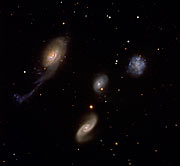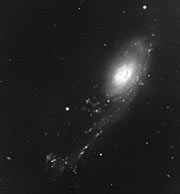Tisková zpráva
Cosmic Portrait of a Perturbed Family
4. listopadu 2005
Image eso0535a shows in amazing details a group of galaxies known as Robert's Quartet [1]. The image is based on data collected with the FORS2 multi-mode instrument on ESO's Very Large Telescope.
Robert's Quartet is a family of four very different galaxies, located at a distance of about 160 million light-years, close to the centre of the southern constellation of the Phoenix. Its members are NGC 87, NGC 88, NGC 89 and NGC 92, discovered by John Herschel in the 1830s. NGC 87 (upper right) is an irregular galaxy similar to the satellites of our Milky Way, the Magellanic Clouds. NGC 88 (centre) is a spiral galaxy with an external diffuse envelope, most probably composed of gas. NGC 89 (lower middle) is another spiral galaxy with two large spiral arms. The largest member of the system, NGC 92 (left), is a spiral Sa galaxy with an unusual appearance. One of its arms, about 100,000 light-years long, has been distorted by interactions and contains a large quantity of dust.
The quartet is one of the finest examples of compact groups of galaxies. Because such groups contain four to eight galaxies in a very small region, they are excellent laboratories for the study of galaxy interactions and their effects, in particular on the formation of stars.
Using another set of VLT data also obtained with FORS2, astronomers [2] were able to study the properties of regions of active star formation ("HII regions" [3]) in the sister members of Robert's Quartet. They found more than 200 of such regions in NGC 92, with a size between 500 and 1,500 light-years. For NGC 87, they detected 56 HII regions, while the two other galaxies appear to have far fewer of them. For NGC 88, however, they found two plume-like features, while NGC 89 presents a ring of enhanced stellar activity. The system is thus clearly showing increased star formation activity, most probably as the result of the interaction between its members. The sisters clearly belong to a perturbed family.
The quartet has a total visual magnitude of almost 13, i.e. it is about 600 times fainter than the faintest object that can be seen with the unaided eye. The brightest member of the group has a magnitude of about 14. On the sky, the four galaxies are all within a circle of radius of 1.6 arcmin, corresponding to about 75,000 light-years.
Poznámky
[1] The group of galaxies was known as a Compact Group since 1977 by J.A. Rose, under the designation Rose 34. Robert's Quartet is also known under the less poetic name of AM 0018-485 from the Catalogue of Southern Peculiar Galaxies and Associations, compiled in 1987 by astronomers Halton "Chip" Arp and Barry Madore. But who is Robert then? As discovered by Australian amateur astronomer Mike Kerr, Arp and Madore named Robert's Quartet after Robert Freedman who generated many of the updated positions of galaxies in the catalogue. The astronomers clearly had a very good sense of humour as the catalogue also contains a system of galaxies called Wendy (ESO 147- 8; for Wendy Freedman) and another called the Conjugal galaxy (ESO 384- 53)!
[2] The astronomers are S. Temporin (University of Innsbruck, Austria), S. Ciroi and P. Rafanelli (University of Padova, Italy), A. Iovino (INAF-Brera Astronomical Observatory, Italy), E. Pompei (ESO), and M. Radovich (INAF-Capodimonte Astronomical Observatory, Italy). (The article describing this result is available in PDF format)
[3] The radiation of young hot stars embedded in an interstellar cloud is able to heat the surrounding gas, resulting in the apparition of an emission nebula that shines mostly in the light of ionized hydrogen (H) atoms. Such nebulae are therefore often referred to as "HII regions". The well-known Orion Nebula is an outstanding example of that type of nebula.
Další informace
Technical information: eso0535a is based on images obtained with the FORS2 multi-mode instrument on ESO's Very Large Telescope on October 30, 1999, during the commissioning phase of the instrument. Observations were done in four different filters : B (8 min exposure), V (4 min), R (3 min) and I (4 min). The data were extracted from the ESO Science Archive and processed by Henri Boffin (ESO). The colour image was finally produced by Kristina Boneva and Haennes Heyer (ESO). North is up and East is to the left. The field of view is about 6x6 arcmin. eso0535b is based on data obtained with the FORS2 instrument on Melipal (UT4) for E. Pompei and A. Iovino in September 2001. The data were extracted from the ESO Science Archive and processed by Henri Boffin (ESO). It is based on 6 images obtained through the H-alpha filter for a total exposure time of 72 minutes. The field of view is about 3x3 arcmin.
Kontakty
Henri Boffin
ESO
Garching, Germany
Tel.: +49 89 3209 6222
Email: hboffin@eso.org
O zprávě
| Tiskové zpráva č.: | eso0535 |
| Legacy ID: | Photo 34a-b/05 |
| Jméno: | Roberts's Quartet |
| Typ: | Local Universe : Galaxy |
| Facility: | Very Large Telescope |
| Instruments: | FORS2 |
Our use of Cookies
We use cookies that are essential for accessing our websites and using our services. We also use cookies to analyse, measure and improve our websites’ performance, to enable content sharing via social media and to display media content hosted on third-party platforms.
ESO Cookies Policy
The European Organisation for Astronomical Research in the Southern Hemisphere (ESO) is the pre-eminent intergovernmental science and technology organisation in astronomy. It carries out an ambitious programme focused on the design, construction and operation of powerful ground-based observing facilities for astronomy.
This Cookies Policy is intended to provide clarity by outlining the cookies used on the ESO public websites, their functions, the options you have for controlling them, and the ways you can contact us for additional details.
What are cookies?
Cookies are small pieces of data stored on your device by websites you visit. They serve various purposes, such as remembering login credentials and preferences and enhance your browsing experience.
Categories of cookies we use
Essential cookies (always active): These cookies are strictly necessary for the proper functioning of our website. Without these cookies, the website cannot operate correctly, and certain services, such as logging in or accessing secure areas, may not be available; because they are essential for the website’s operation, they cannot be disabled.
Functional Cookies: These cookies enhance your browsing experience by enabling additional features and personalization, such as remembering your preferences and settings. While not strictly necessary for the website to function, they improve usability and convenience; these cookies are only placed if you provide your consent.
Analytics cookies: These cookies collect information about how visitors interact with our website, such as which pages are visited most often and how users navigate the site. This data helps us improve website performance, optimize content, and enhance the user experience; these cookies are only placed if you provide your consent. We use the following analytics cookies.
Matomo Cookies:
This website uses Matomo (formerly Piwik), an open source software which enables the statistical analysis of website visits. Matomo uses cookies (text files) which are saved on your computer and which allow us to analyze how you use our website. The website user information generated by the cookies will only be saved on the servers of our IT Department. We use this information to analyze www.eso.org visits and to prepare reports on website activities. These data will not be disclosed to third parties.
On behalf of ESO, Matomo will use this information for the purpose of evaluating your use of the website, compiling reports on website activity and providing other services relating to website activity and internet usage.
Matomo cookies settings:
Additional Third-party cookies on ESO websites: some of our pages display content from external providers, e.g. YouTube.
Such third-party services are outside of ESO control and may, at any time, change their terms of service, use of cookies, etc.
YouTube: Some videos on the ESO website are embedded from ESO’s official YouTube channel. We have enabled YouTube’s privacy-enhanced mode, meaning that no cookies are set unless the user actively clicks on the video to play it. Additionally, in this mode, YouTube does not store any personally identifiable cookie data for embedded video playbacks. For more details, please refer to YouTube’s embedding videos information page.
Cookies can also be classified based on the following elements.
Regarding the domain, there are:
- First-party cookies, set by the website you are currently visiting. They are stored by the same domain that you are browsing and are used to enhance your experience on that site;
- Third-party cookies, set by a domain other than the one you are currently visiting.
As for their duration, cookies can be:
- Browser-session cookies, which are deleted when the user closes the browser;
- Stored cookies, which stay on the user's device for a predetermined period of time.
How to manage cookies
Cookie settings: You can modify your cookie choices for the ESO webpages at any time by clicking on the link Cookie settings at the bottom of any page.
In your browser: If you wish to delete cookies or instruct your browser to delete or block cookies by default, please visit the help pages of your browser:
Please be aware that if you delete or decline cookies, certain functionalities of our website may be not be available and your browsing experience may be affected.
You can set most browsers to prevent any cookies being placed on your device, but you may then have to manually adjust some preferences every time you visit a site/page. And some services and functionalities may not work properly at all (e.g. profile logging-in, shop check out).
Updates to the ESO Cookies Policy
The ESO Cookies Policy may be subject to future updates, which will be made available on this page.
Additional information
For any queries related to cookies, please contact: pdprATesoDOTorg.
As ESO public webpages are managed by our Department of Communication, your questions will be dealt with the support of the said Department.


